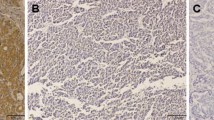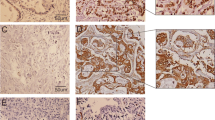Abstract
Gallbladder cancers (GBC) are associated with high disease-specific mortality rates because of no means of early detection and effective therapies. In this study, we investigated CD146 expression, microvessel densities, and lymph vessel densities in 108 adenocarcinomas, 15 gallbladder polyps, 35 chronic cholecystitis tissues, and 46 peritumoral tissues using immunohistochemistry. We demonstrated that positive CD146 expression, and average microvessel and lymph vessel counts in gallbladder adenocarcinomas were significantly higher than those in peritumoral tissues, polyps, and chronic cholecystitis (ps < 0.01). Positive CD146 expression, and average microvessel and lymph vessel counts were also significantly lower in cases with well-differentiated adenocarcinoma, maximal tumor diameter <2 cm, no metastasis of lymph node, and no invasion of regional tissues than in cases with poorly differentiated adenocarcinoma, maximal tumor diameter ≥2 cm, metastasis in lymph nodes, and invasion of regional tissues (p < 0.05 or p < 0.01). Univariate Kaplan–Meier analysis showed that increased expression of CD146 (p = 0.056), higher average microvessel counts (p < 0.05), and lymph vessel counts (p < 0.05) were associated with decreased overall survival. Multivariate Cox regression analysis showed that average microvessel and lymph vessel counts (ps < 0.05) were independent prognostic predictors in gallbladder adenocarcinoma. Our study suggested that the elevated expression of CD146, angiogenesis, and lymphangiogenesis might be closely related to progression, invasion, metastasis, and prognosis of gallbladder adenocarcinoma.




Similar content being viewed by others
References
Jones RS. Carcinoma of the gallbladder. Surg Clin North Am. 1990;70:1419–28.
Carriaga MT, Henson DE. Liver, gallbladder, extrahepatic bile ducts, and pancreas. Cancer. 1995;75:171–90.
Ootani T, Shirai Y, Tsukada K, Muto T. Relationship between gallbladder carcinoma and the segmental type of adenomyomatosis of the gallbladder. Cancer. 1992;69:2647–52.
Jayaraman S, Jarnagin WR. Management of gallbladder cancer. Gastroenterol Clin North Am. 2010;39:331–42.
Gatto M, Bragazzi MC, Semeraro R, et al. Cholangiocarcinoma: update and future perspectives. Dig Liver Dis. 2010;42:253–60.
Hawkins WG, DeMatteo RP, Jarnagin WR, Ben-Porat L, Blumgart LH, Fong Y. Jaundice predicts advanced disease and early mortality in patients with gallbladder cancer. Ann Surg Oncol. 2004;11:310–5.
Jayaraman S, Jarnagin WR. Management of gallbladder cancer. Gastroenterol Clin North Am. 2010;39:331–42.
Maurya SK, Tewari M, Mishra RR. Genetic aberrations in gallbladder cancer. Surg Oncol. 2010; Sep 28. [Epub ahead of print]
Loges S, Clausen H, Reichelt U, Bubenheim M, Erbersdobler A, Schurr P, et al. Determination of microvessel density by quantitative real-time PCR in esophageal cancer: correlation with histologic methods, angiogenic growth factor expression, and lymph node metastasis. Clin Cancer Res. 2007;13:76–80.
Risau W. Mechanisms of angiogenesis. Nature. 1997;386:671–4.
He Y, Karpanen T, Alitalo K. Role of lymphangiogenic factors in tumor metastasis. Biochim Biophys Acta. 2004;1654:3–12.
Delatorre NG, Buley I, Wass JA, et al. Angiogenesis and lymphangiogenesis in thyroid proliferative lesions: relationship to type and tumor behaviors. Endocr Relat Cancer. 2006;13:934–44.
Aldovinni D, Demichelis F, Doglioni C, Di Vizio D, Galligioni E, Brugnara S, et al. MCAM expression as marker of prognosis in epithelial ovarian cancer. Int J Cancer. 2006;119:1920–6.
Hasan J, Byers R, Jayson GC. Intra-tumoural microvessel density in human solid tumours. Br J Cancer. 2002;86:1566–77.
Beenken SW, Bland KI. Biomarkers for breast cancer. Minerva Chir. 2002;57:437–48.
Legan M. New marker of angiogenesis CD105 (endoglin): diagnostic, prognostic and therapeutic role. Radiol Oncol. 2005;39:253–9.
Mineo TC, Ambrogi V, Baldi A, Rabitti C, Bollero P, Vincenzi B, et al. Prognostic impact of VEGF, CD31, CD34, and CD105 expression and tumour vessel invasion after radical surgery for IB–IIA non-small cell lung cancer. J Clin Pathol. 2004;57:591–7.
Sundar SS, Ganesan TS. Role of lymphangiogenesis in cancer. J Clin Oncol. 2007;25:4298–07.
Mumprecht V, Detmar M. Lymphangiogenesis and cancer metastasis. J Cell Mol Med. 2009;13:1405–16.
Kahn HJ, Bailey D, Marks A. Monoclonal antibody D2-40, a new marker of lymphatic endothelium, reacts with Kaposi’s and a subset of angiosarcomas. Mod Pathol. 2002;15:434–40.
Chu AY, Litzky LA, Pasha TL, Acs G, Zhang PJ. Utility of D2-40, a novel mesothelial marker, in the diagnosis of malignant mesothelioma. Modern Pathol. 2005;18:105–10.
Lehmann JM, Riethmuller G, Johnson JP. MUC18, a marker of tumor progression in human melanoma, shows sequence similarity to the neural cell adhesion molecules of the immunoglobulin superfamily. Proc Natl Acad Sci USA. 1989;86:9891–5.
Ouhtit A, Gaur RL, Abd Elmageed ZY, Fernando A, Thouta R, Trappey AK, et al. Towards understanding the mode of action of the multifaceted cell adhesion receptor CD146. Biochim Biophys Acta. 2009;1795:130–6.
Garcia S, Dales JP, Charafe-Jauffret E, Carpentier-Meunier S, Andrac-Meyer L, Jacquemier J, et al. Poor prognosis in breast carcinomas correlates with increased expression of targetable CD146 and C-Met and with proteomic basal-like phenotype. Hum Pathol. 2007;38:830–41.
Watson-Hurst K, Becker D. The role of N-cadherin, MCAM and beta3 integrin in melanoma progression, proliferation, migration and invasion. Cancer Biol Ther. 2006;5:1375–82.
Yang H, Wang S, Liu Z, Wu MH, McAlpine B, Ansel J, et al. Isolation and characterization of mouse MUC18 cDNA gene, and correlation of MUC18 expression in mouse melanoma cell lines with metastatic ability. Gene. 2001;265:133–45.
Jayaraman S, Jarnagin WR. Management of gallbladder cancer. Gastroenterol Clin North Am. 2010;39:331–42.
Yamagiwa H, Tomiyama H, Yoshimura H. Histogenesis of carcinoma of gallbladder. Histological study of serial sections of 1000 cases of resected gallbladder. Rinsho Byori. 1986;34:475–80.
Dowling GP, Kelly JK. The histogenesis of adenocarcinoma of the gallbladder. Cancer. 1986;58:1702–8.
Sanada Y, Yoshida K, Ohara M, Tsutani Y. Expression of orotate phosphoribosyltransferase (OPRT) in hepatobiliary and pancreatic carcinoma. Pathol Oncol Res. 2007;13:105–13.
Chang HJ, Yoo BC, Kim SW, Lee BL, Kim WH. Significance of PML and p53 protein as molecular prognostic markers of gallbladder carcinomas. Pathol Oncol Res. 2007;13:326–35.
Tucek S, Tomasek J, Halámkova J. Bile duct malignancies. Klin Onkol. 2010;23:231–41.
Malik IA. Gallbladder cancer: current status. Expert Opin Pharmacother. 2004;5:1271–7.
Bergers G, Benjamin LE. Tumorigenesis and the angiogenic switch. Nat Rev Cancer. 2003;3:401–10.
Sugawara Y, Makuuchi M, Harihara Y, Noie T, Inoue K, Kubota K, et al. Tumor angiogenesis in gallbladder carcinoma. Hepatogastroenterology. 1999;46:1682–6.
Giatromanolaki A, Sivridis E, Koukourakis MI, Polychronidis A, Simopoulos C. Prognostic role of angiogenesis in operable carcinoma of the gallbladder. Am J Clin Oncol. 2002;25:38–41.
Weidner N, Semple JP, Welch WR, Folkman J. Tumor angiogenesis and metastasis correlation in invasive breast carcinoma. N Engl J Med. 1991;324:1–8.
Iiizumi M, Liu W, Pai SK, Furuta E, Watabe K. Drug development against metastasis-related genes and their pathways: a rationale for cancer therapy. Biochim Biophys Acta. 2008;1786:87–104.
Dumoff KL, Chu C, Xu X, Pasha T, Zhang PJ, Acs G. Low D2-40 immunoreactivity correlates with lymphatic invasion and nodal metastasis in early-stage squamous cell carcinoma of the uterine cervix. Mod Pathol. 2005;18:97–104.
Kadota K, Huang CL, Liu D, Ueno M, Kushida Y, Haba R, et al. The clinical significance of lymphangiogenesis and angiogenesis in non-small cell lung cancer patients. Eur J Cancer. 2008;44:1057–67.
Hardavella G, Arkoumani E, Dalavanga Y, Galanis P, Agnantis NJ, Constantopoulos S, et al. Prognostic impact of lymphangiogenesis and lymphatic invasion (CD105 expression) in small cell lung carcinoma. Anticancer Res. 2008;28:343–7.
Thelen A, Scholz A, Benckert C, Weichert W, Dietz E, Wiedenmann B, et al. Tumor-associated lymphangiogenesis correlates with lymph node metastases and prognosis in hilar cholangiocarcinoma. Ann Surg Oncol. 2008;15:791–9.
Kristiansen G, Yu Y, Schlüns K, Sers C, Dietel M, Petersen I. Expression of the cell adhesion molecule CD146/MCAM in non-small cell lung cancer. Anal Cell Pathol. 2003;25:77–81.
Walgenbach-Bruenagel G, Tolba RH, Varnai AD, Bollmann M, Hirner A, Walgenbach KJ. Detection of lymphatic invasion in early stage primary colorectal cancer with the monoclonal antibody D2-40. Eur Surg Res. 2006;38:438–44.
Jackson DG. Lymphatic markers, tumour lymphangiogenesis and lymph node metastasis. Cancer Treat Res. 2007;135:39–53.
Chambers AF, Groom AC, MacDonald IC. Dissemination and growth of cancer cells in metastatic sites. Nat Rev Cancer. 2002;2:563–72.
Shih IM. The role of CD146 (Mel-CAM) in biology and pathology. J Pathol. 1999;189:4–11.
Conflicts of interest
None
Author information
Authors and Affiliations
Corresponding author
Rights and permissions
About this article
Cite this article
Wang, W., Yang, Zl., Liu, Jq. et al. Identification of CD146 expression, angiogenesis, and lymphangiogenesis as progression, metastasis, and poor-prognosis related markers for gallbladder adenocarcinoma. Tumor Biol. 33, 173–182 (2012). https://doi.org/10.1007/s13277-011-0260-8
Received:
Accepted:
Published:
Issue Date:
DOI: https://doi.org/10.1007/s13277-011-0260-8




